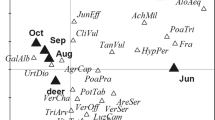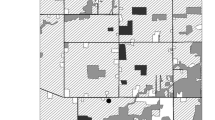Abstract
For many plant species in eastern North America, short observed seed dispersal distances (ranging up to a few tens of meters) fail to explain rapid rates of invasion and migration. This discrepancy points to a substantial gap in our knowledge of the mechanisms by which seeds are dispersed long distances. We investigated the potential for white-tailed deer (Odocoileus virginianus Zimm.), the dominant large herbivore in much of eastern North America, to disperse seeds via endozoochory. This is the first comprehensive study of seed dispersal by white-tailed deer, despite a vast body of research on other aspects of their ecology. More than 70 plant species germinated from deer feces collected over a 1-year period in central New York State, USA. Viable seeds included native and alien herbs, shrubs, and trees, including several invasive introduced species, from the full range of habitat types in the local flora. A mean of >30 seeds germinated per fecal pellet group, and seeds were dispersed during all months of the year. A wide variety of presumed dispersal modes were represented (endo- and exozoochory, wind, ballistic, ant, and unassisted). The majority were species with small-seeded fruits having no obvious adaptations for dispersal, underscoring the difficulty of inferring dispersal ability from diaspore morphology. Due to their broad diet, wide-ranging movements, and relatively long gut retention times, white-tailed deer have tremendous potential for effecting long-distance seed dispersal via ingestion and defecation. We conclude that white-tailed deer represent a significant and previously unappreciated vector of seed dispersal across the North American landscape, probably contributing an important long-distance component to the seed shadows of hundreds of plant species, and providing a mechanism to help explain rapid rates of plant migration.

Similar content being viewed by others
References
Anderson RC, Corbett EA, Anderson MR, Corbett GA, Kelley TM (2001) High white-tailed deer density has negative impact on tallgrass prairie forbs. J Torrey Bot Soc 128:381–392
Augustine DJ, Jordan PA (1998) Predictors of white-tailed deer grazing intensity in fragmented deciduous forests. J Wildl Manage 62:1076–1085
Baird WV, Riopel JL (1985) Life history studies of Conopholis americana (Orobanchaceae). Am Midl Nat 116:140–151
Baskin CC, Baskin JM (1998) Seeds: ecology, biogeography, and evolution of dormancy and germination. Academic Press, New York
Bierzychudek P (1982) Life histories and demography of shade-tolerant forest herbs: a review. New Phytol 90:757–776
Bruun HH, Fritzbøger B (2002) The past impact of livestock husbandry on dispersal of plant seeds in the landscape of Denmark. Ambio 31:425–431
Bullock JM, Kenward RE, Hails RS (eds) (2002) Dispersal ecology: the 42nd symposium of the British Ecological Society held at the University of Reading, 2–5 April 2001. Blackwell, Oxford
Cain ML, Damman H, Muir A (1998) Seed dispersal and the Holocene migration of woodland herbs. Ecol Monogr 68:325–347
Cain ML, Milligan BG, Strand AE (2000) Long-distance seed dispersal in plant populations. Am J Bot 87:1217–1227
Campbell JE, Gibson DJ (2001) The effect of seeds of exotic species transported via horse dung on vegetation along trail corridors. Plant Ecol 157:23–35
Dinerstein E (1989) The foliage-as-fruit hypothesis and the feeding behavior of South Asian ungulates. Biotropica 21:214–218
Dore WG, Raymond LC (1942) Viable seeds in pasture soil and manure. Sci Agric 23:69–79
Flinn KM, Marks PL (2004) Land use history and forest herb diversity in Tompkins County, New York, USA. In: Honnay O, Verheyen K, Bossuyt B, Hermy M (eds) Forest biodiversity: lessons from history for conservation. CABI, New York, pp 81–95
Gardener CJ, McIvor JG, Jansen A (1993) Passage of legume and grass seeds through the digestive tract of cattle and their survival in faeces. J Appl Ecol 30:63–74
Gill RMA, Beardall V (2001) The impact of deer on woodlands: the effects of browsing and seed dispersal on vegetation structure and composition. Forestry 74:209–218
Gleason HA, Cronquist A (1991) Manual of vascular plants of northeastern United States and adjacent Canada, 2nd edn. The New York Botanical Garden, Bronx, New York
Gonzalez-Espinosa M, Quintana-Ascencio PF (1986) Seed predation and dispersal in a dominant desert plant: Opuntia, ants, birds, and mammals. In: Estrada A, Fleming TH (eds) Frugivores and seed dispersal. Junk, Dordrecht, pp 273–284
Grashof-Bokdam CJ, Geertsema W (1998) The effect of isolation and history on colonization patterns of plant species in secondary woodland. J Biogeogr 25:837–846
Halls LK (ed) (1984) White-tailed deer: ecology and management. Stackpole, Harrisburg, Penn.
Heinken T, Hanspach H, Raudnitschka D, Schaumann F (2002) Dispersal of vascular plants by four species of wild mammals in a deciduous forest in NE Germany. Phytocoenologia 32:627–643
Hughes L, Dunlop M, French K, Leishman MR, Rice B, Rodgerson L, Westoby M (1994) Predicting dispersal spectra: a minimal set of hypotheses based on plant attributes. J Ecol 82:933–950
Janzen DH (1984) Dispersal of small seeds by big herbivores: foliage is the fruit. Am Nat 123:338–353
Janzen DH (1985) Spondias mombin is culturally deprived in megafauna-free forest. J Trop Ecol 1:131–155
Kramp BA, Ansley RJ, Tunnell TR (1998) Survival of mesquite seedlings emerging from cattle and wildlife feces in a semi-arid grassland. Southwest Nat 43:300–312
Lay DW (1965) Fruit utilization by deer in southern forests. J Wildl Manage 29:370–375
Lesage L, Crête M, Huot J, Dumont A, Oellet J-P (2000) Seasonal home range size and philopatry in two northern white-tailed deer populations. Can J Zool 78:1930–1940
Mal TK, Lovett-Doust J, Lovett-Doust L, Mulligan GA (1992) The biology of Canadian weeds. 101. Lythrum salicaria. Can J Plant Sci 72:1305–1330
Malo JE, Suárez F (1995) Herbivorous mammals as seed dispersers in a Mediterranean dehesa. Oecologia 104:246–255
Malo JE, Jiménez B, Suárez F (2000) Herbivore dunging and endozoochorous seed deposition in a Mediterranean dehesa. J Range Manage 53:322–328
Marks PL (1983) On the origin of the field plants of the northeastern United States. Am Nat 122:210–228
Matlack GR (1994) Plant species migration in a mixed-history forest landscape in eastern North America. Ecology 75:1491–1502
Mautz WW, Petrides GA (1971) Food passage rate in the white-tailed deer. J Wildl Manage 35:723–731
Miller TF, Mladenoff DJ, Clayton MK (2002) Old-growth northern hardwood forests: spatial autocorrelation and patterns of understory vegetation. Ecol Monogr 72:487–503
Müller-Schneider P (1986) Verbreitungsbiologie der Blütenpflanzen Graubündens. Veröff Geobot Inst ETH, Stiftung Rübel, Zürich 85:1–268
Murray DR (ed) (1986) Seed dispersal. Academic Press, Sydney
Pakeman RJ (2001) Plant migration rates and seed dispersal mechanisms. J Biogeogr 28:795–800
Pakeman RJ, Digneffe G, Small JL (2002) Ecological correlates of endozoochory by herbivores. Funct Ecol 16:296–304
Pijl L van der (1982) Principles of dispersal in higher plants. Springer, Berlin Heidelberg New York
Pitelka LF (1997) Plant migration and climate change. Am Sci 85:464–473
Poschlod P, Bonn S (1998) Changing dispersal processes in the central European landscape since the last ice age: an explanation for the actual decrease of plant species richness in different habitats? Acta Bot Neerl 47:27–44
Ridley HN (1930) The dispersal of plants throughout the world. Reeve, Ashford, UK
Rogers LL (1987) Seasonal changes in defecation rates of free-ranging white-tailed deer. J Wildl Manage 51:330–333
Rooney TA (2001) Deer impacts on forest ecosystems: a North American perspective. Forestry 74:201–208
Rouleau I, Crête M, Ouellet J-P (2002) Contrasting the summer ecology of white-tailed deer inhabiting a forested and an agricultural landscape. Écoscience 9:459–469
Salisbury E (1964) Weeds and aliens, 2nd edn. Collins, London
Sayre RW, Decker DJ, Good GL (1992) Deer damage to landscape plants in New York State: perceptions of nursery producers, landscape firms, and homeowners. J Environ Hortic 10:46–51
Singleton R, Gardescu S, Marks PL, Geber MA (2001) Forest herb colonization of postagricultural forests in central New York State, USA. J Ecol 18:325–338
Tzilkowski WM, Brittingham MC, Lovallo MJ (2002) Wildlife damage to corn in Pennsylvania: farmer and on-the-ground estimates. J Wildl Manage 66:678–682
Uva RH, Neal JC, DiTomaso JM (1997) Weeds of the Northeast. Cornell University Press, Ithaca, NY
Vellend M (2002) A pest and an invader: white-tailed deer (Odocoileus virginianus Zimm.) as a seed dispersal agent for honeysuckle shrubs (Lonicera L.). Nat Areas J 22:230–234
Vellend M, Myers JA, Gardescu S, Marks PL (2003) Dispersal of Trillium seeds by deer: implications for long-distance migration of forest herbs. Ecology 84:1067–1072
Verheyen K, Honnay O, Motzkin G, Hermy M, Foster DR (2003) Response of forest plant species to land-use change: a life-history trait-based approach. J Ecol 91:563–577
Welch D (1985) Studies in the grazing of heather moorland in north-east Scotland. IV. Seed dispersal and plant establishment in dung. J Appl Ecol 22:461–472
Wigley TB, Johnson MK (1981) Disappearance rates for deer pellets in the southeast. J Wildl Manage 45:251–253
Willson MF (1993) Dispersal mode, seed shadows, and colonization patterns. Vegetatio 107/108:261–280
Willson MF, Rice BL, Westoby M (1990) Seed dispersal spectra: a comparison of temperate plant communities. J Veg Sci 1:547–562
Winters C, Quillen L (eds) (2001) The worst of the worst. Newsletter of the Invasive Plant Council of New York State 3, 1
Acknowledgements
We are grateful to R. Hirsch for field and laboratory assistance, and F.R. Wesley and C.L. Mohler for help with species identifications. We thank J. Anderson, J. Bellemare, K. Flinn, P. Harcombe, L. Sack, and the reviewers for their comments on the manuscript. This project was funded by grants from the A.W. Mellon Foundation and the McIntire-Stennis program (to P.L.M.), the Cornell University Biological Sciences Honors Program (to J.A.M.), and a STAR Fellowship from the U.S. Environmental Protection Agency (to M.V.).
Author information
Authors and Affiliations
Corresponding author
Electronic Supplementary Material
Rights and permissions
About this article
Cite this article
Myers, J.A., Vellend, M., Gardescu, S. et al. Seed dispersal by white-tailed deer: implications for long-distance dispersal, invasion, and migration of plants in eastern North America. Oecologia 139, 35–44 (2004). https://doi.org/10.1007/s00442-003-1474-2
Received:
Accepted:
Published:
Issue Date:
DOI: https://doi.org/10.1007/s00442-003-1474-2




